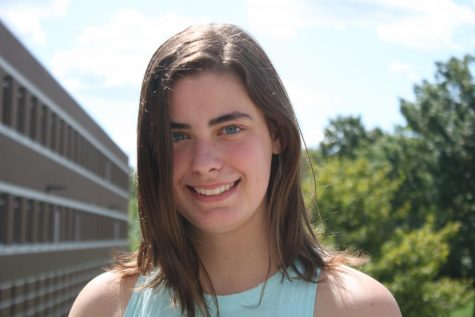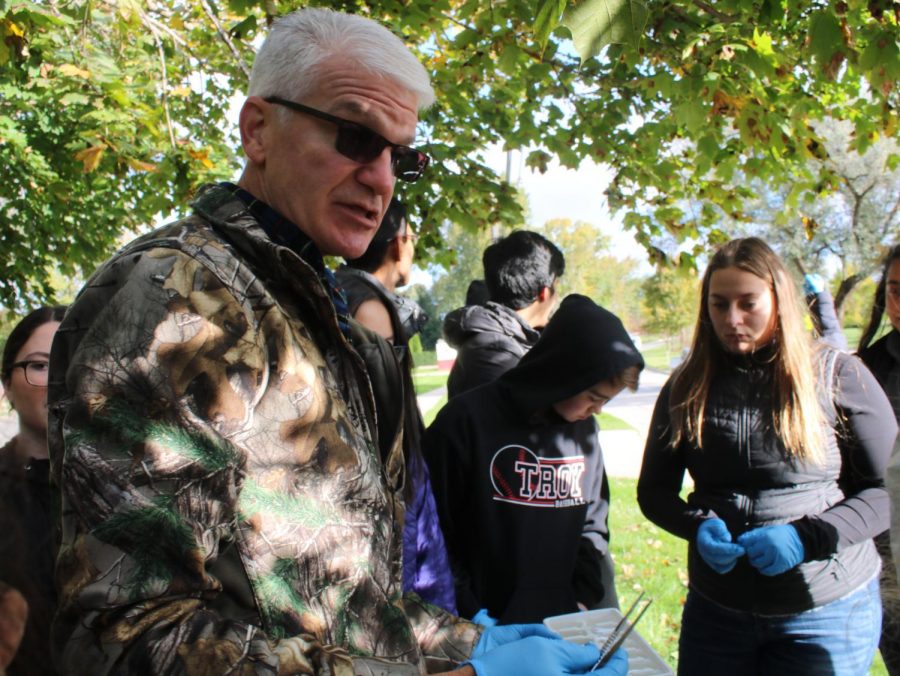Reporting From the Rouge River
AP Environmental Science teacher Rob Zynda explains what his students need to be doing.
Algae blooms continue to threaten the polluted waters of Lake Erie. Toxic levels of lead in water harmed many of Flint’s occupants. Animals and plants along the shoreline of the Kalamazoo River were affected by an oil spill that took more than five years to clean up. The Rouge River, that many students may recall passing by on their way to school on the corner of Coolidge and Long Lake, was once the most polluted river in Michigan. It even caught fire.
Due to the poor water quality nationwide, the Clean Water Act of 1972 was passed to better regulate pollution in the nation’s water systems. On a more local status in 1986, the Friends of the Rouge started annual clean-up events of the river. The Friends of the Rouge continue to keep the Rouge River within safe levels for the surrounding communities and keep pollution out of the river.
“Our mission is to restore, protect, and enhance the Rouge River watershed through stewardship, education, and collaboration,” Erin Cassady, program manager of the Rouge Education Project, said. “We envision a future where a clean and vibrant Rouge River is the center of our community. Individual and community actions protect and improve the health of the Rouge River, assuring that its natural, economic, and recreational value enhances the quality of life in the Rouge River ecosystem.”
This fall, 17 schools along the Rouge River went out as a part of the Rouge Education Project. Typically, there are around 30 schools that go out between the fall and spring outings. Cassady said that over the past 20 years, the health of the Rouge River has improved.
“Students in urban and suburban environments tend to lack the exposure to nature that can enrich their educational experience and connect them to their local community and region,” Cassady said. “Project-based work outside of the classroom can provide the hands-on learning needed to forge a deeper understanding of nature and a stronger sense of place, both of which can increase students’ propensity to become active citizens and stewards. This work also provides a publicly accessible data set, and there is no other entity monitoring the river as frequently as we do at Friends of the Rouge through our various programs. It allows to flag problem areas. Schools and volunteers are our eyes on the river!”
Science Teachers Amanda Chin and Robert Zynda brought their Environmental Science classes to the Rouge to help study the water quality levels.
Zynda and his students have been using nine advanced testing kits to test the Rouge river since the mid to late 1990s to early 2000s. Students perform both chemical and physical tests: dissolved oxygen, pH, Biochemical Oxygen Demand, change in temperature, total phosphates, nitrates, fecal coliform, turbidity and total solids. Dissolved oxygen is the amount of oxygen available for the species in the water. PH is how acidic or alkalinity of the water is. Biochemical Oxygen Demand is the amount of oxygen organisms need in order to decompose; this is used to measure pollution. Fecal coliform is the quantitative amount of fecal produced from warm-blooded species. Turbidity is the amount of cloudiness or clearness of the water.
Last spring Zynda’s class observed the overall water quality index of the Rouge River to be 66.77, on a scale from 0 to 100. This makes the water quality index to be at a medium level, higher than bad, but lower than good. This fall, the class noticed a slight increase in water quality of the river. They noticed an overall WQI of 70.55, which falls on the lower side of what is considered good, 70-90. The impoundment has a lower WQI of 59.65. Allen Burton, a professor at the School of Education and Allied Sciences and the Department of Earth & Environmental Sciences at the University of Michigan, hypothesizes why the impoundment is lower than the river.
“Impoundments tend to have lower water quality since nutrients and contaminants from storm runoff can become elevated through time – due to the lack of flushing found in rivers,” Burton said. “As water sits behind the dam, it allows algae to grow from the higher nutrients, warmer waters, abundance of sunlight (not shaded as rivers can be) and quieter waters.”
Due to the amount of years Zynda has been comp“For us, most science classes are just memorizing stuff and it’s not really application that much,” Li said. “To go out in the field, personally, I think was meaningful because we could experience how you could apply science to real life stuff like career because you know people do this.”
Junior Lily Renke emphasizes the importance of knowing what is going on in one’s community.
“[The Rouge River is] something we drive by everyday and never think much about so it’s good to see something in our community, which we think so highly of, to look at it and test it ourselves to see the damage we’re doing in our own community,” she said.
Keeping the water within normal levels is an integral part of maintaining a safe and clean community. People can contribute to safer levels by refraining from polluting and being cautious to the other species in the ecosystem. Water-testing can help bring students into an important area of research, inform citizens, assist local scientists and shape political leaders and community action.
leting testing, Zynda has noticed general trends among the results.
“The main trend that I’ve seen for a couple of decades is that the fecal coliform count has definitely declined,” he said. “There was a big push to manage disease in the nineties and early two-thousands, there were goose round-ups and they were moving them. They were making sure their eggs didn’t survive all that. I think that really brought down the population to a point where you’re not seeing the effects of water quality-wise that you used to see then.”
Disease management may be a factor in why Cassady has seen a general increase in water-quality in the past 20 years. Zynda accounts that different regions of the river will have different levels for the tests.
“The Rouge up here is the headwaters,” Zynda said. “It begins north of South Boulevard in Rochester Hills. Have you ever been to Wayne Stage Nature Center in Troy? That pond, that small stream, that’s Rouge. It then goes to Firefighters, the water there, the pond, the river, that’s all Rouge water. Then it makes its way to Hamilton Elementary and then when we test at Long Lake and Coolidge. And that Rouge goes all the way to the Detroit River where it dumps it there.”
Zynda helps his environmental science classes learn how to test the quality of water by giving them readings, making them practice each test beforehand, and demonstrating many of the tests to them. Senior Lauren Ball was one of those students. She was tasked with finding micro-invertebrate data.
“We were looking for certain kinds of leeches, certain kinds of the fly nymph, and we were actually pretty successful with that,” Ball said. “We found a crayfish in our hour, which was our biggest find. It was pretty big, probably about the size of my hand, a bit bigger.”
Senior Emily Wu, another student of Zynda’s, found meaning in going out to the Rouge and being more hands-on.
“First of all, I think it’s pretty exciting because it’s something different, I suppose, instead of just sitting in the classroom and learning about things through paper,” Wu said. “Through tests, we actually get to go outside and be a part of something that’s bigger than ourselves in a way and really get hands-on experience, which I think is a more profound experience.”
It also helped her to learn how to better collect data.
“It’s important to be precise and to really be confident in your procedure,” Wu said. “You really want to make sure that you know what you’re doing.”
Similar to Wu, senior Michelle Li finds going to the Rouge beneficial from a learning standpoint.
“For us, most science classes are just memorizing stuff and it’s not really application that much,” Li said. “To go out in the field, personally, I think was meaningful because we could experience how you could apply science to real life stuff like career because you know people do this.”
Junior Lily Renke emphasizes the importance of knowing what is going on in one’s community.
“[The Rouge River is] something we drive by everyday and never think much about so it’s good to see something in our community, which we think so highly of, to look at it and test it ourselves to see the damage we’re doing in our own community,” she said.
Keeping the water within normal levels is an integral part of maintaining a safe and clean community. People can contribute to safer levels by refraining from polluting and being cautious to the other species in the ecosystem. Water-testing can help bring students into an important area of research, inform citizens, assist local scientists and shape political leaders and community action.
Your donation will support the student journalists of Troy High School - MI. Your contribution will allow us to print our work, purchase equipment and cover our annual website hosting costs.


